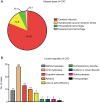Clinical course and outcomes of COVID-19 patients with a history of cerebrovascular disease: a retrospective study in Wuhan
- PMID: 34277788
- PMCID: PMC8267260
- DOI: 10.21037/atm-21-2237
Clinical course and outcomes of COVID-19 patients with a history of cerebrovascular disease: a retrospective study in Wuhan
Abstract
Background: Data on patients with coronavirus disease 2019 (COVID-19) who have pre-existing cerebrovascular disease (CVD) are scarce. This study set out to describe the clinical course and outcomes of these patients.
Methods: This single-center retrospective study was performed at Huoshenshan Hospital in Wuhan, China. Patients with confirmed COVID-19 who had pre-existing CVD (N=69) were identified. COVID-19 patients without CVD were randomly selected and matched by age and sex to the patients with CVD. Clinical data were analyzed and compared between the 2 groups. The composite endpoint included intensive care unit admission, use of mechanical ventilation, and death. Multivariable Cox regression analyses with control for medical comorbidities were used to examine the relationship between pre-existing CVD and clinical outcome of COVID-19.
Results: Compared with patients without CVD, patients with pre-existing CVD were more likely to present with unapparent symptoms at first; however, at admission, these patients tended to be in a severer condition than those without CVD, with more underlying hypertension and diabetes. The levels of interleukin-6, creative kinase MB, aspartate transaminase, and creatinine, as well as prothrombin time, were also markedly higher in patients with CVD. Patients with pre-existing CVD were more likely to develop multi-organ dysfunction, deteriorate to critical condition, and yield poorer clinical outcomes than patients without CVD. Concerning therapeutics, greater proportions of patients with pre-existing CVD required mechanical ventilation, higher-order anti-bacterials, and drugs targeting underlying diseases and complications. In the multivariable analysis, pre-existing CVD was significantly associated with a poor clinical outcome.
Conclusions: Patients with a history of CVD are more vulnerable to an over-activated inflammatory response and subsequent multi-organ dysfunction, resulting in a poor clinical outcome. Close monitoring is advisable for these patients.
Keywords: Coronavirus disease 2019 (COVID-19); cerebrovascular disease (CVD); clinical course; clinical outcome; severe acute respiratory syndrome coronavirus-2 (SARS-CoV-2).
2021 Annals of Translational Medicine. All rights reserved.
Conflict of interest statement
Conflicts of Interest: All authors have completed the ICMJE uniform disclosure form (available at http://dx.doi.org/10.21037/atm-21-2237). LL serves as an unpaid editorial board member of Annals of Translational Medicine from Apr 2020 to Mar 2022. The authors have no other conflicts of interest to declare.
Figures



Similar articles
-
Clinical course and outcomes of COVID-19 patients with chronic obstructive pulmonary disease: A retrospective observational study in Wuhan, China.Medicine (Baltimore). 2022 May 6;101(18):e29141. doi: 10.1097/MD.0000000000029141. Medicine (Baltimore). 2022. PMID: 35550462 Free PMC article.
-
Clinical Characteristics, Outcomes, and Risk Factors of Disease Severity in Patients With COVID-19 and With a History of Cerebrovascular Disease in Wuhan, China: A Retrospective Study.Front Neurol. 2022 Jan 11;12:706478. doi: 10.3389/fneur.2021.706478. eCollection 2021. Front Neurol. 2022. PMID: 35087460 Free PMC article.
-
Clinical and Epidemiological Features of SARS-CoV-2 Patients in SARI Ward of a Tertiary Care Centre in New Delhi.J Assoc Physicians India. 2020 Jul;68(7):19-26. J Assoc Physicians India. 2020. PMID: 32602676
-
Predictors of adverse prognosis in COVID-19: A systematic review and meta-analysis.Eur J Clin Invest. 2020 Oct;50(10):e13362. doi: 10.1111/eci.13362. Epub 2020 Aug 27. Eur J Clin Invest. 2020. PMID: 32726868
-
Maternal and infant outcomes of full-term pregnancy combined with COVID-2019 in Wuhan, China: retrospective case series.Arch Gynecol Obstet. 2020 Sep;302(3):545-551. doi: 10.1007/s00404-020-05573-8. Epub 2020 Jul 21. Arch Gynecol Obstet. 2020. PMID: 32696241 Free PMC article. Review.
Cited by
-
Clinical Features and Treatment of Patients Infected With SARS-CoV-2 Omicron Variant While Hospitalized Due to Stroke: A Single Center Study in Japan.Cureus. 2024 Feb 23;16(2):e54760. doi: 10.7759/cureus.54760. eCollection 2024 Feb. Cureus. 2024. PMID: 38523985 Free PMC article.
References
-
- Coronavirus disease (COVID-19) Weekly Epidemiological Update and Weekly Operational Update. Available online: https://www.who.int/emergencies/diseases/novel-coronavirus-2019/situatio.... Date last updated: March 22 2021; Accessed: March 22, 2021.
LinkOut - more resources
Full Text Sources
Miscellaneous
